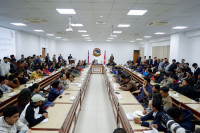National
Current mechanisms failing against climate challenges
Continuation of a reactive approach such as providing relief after a disaster is unhelpful, experts say.
Arjun Poudel
On Sunday, Kagbeni of Mustang district witnessed a massive flood triggered by extremely heavy rainfall, which swept away around three dozen houses and displaced more than 150 people.
A massive flood had caused huge damage to private as well as public properties, and infrastructure including a school building in Chame, the district headquarters of Manang, in June 2021 as well.
Manang and Mustang are the two Nepali districts lying across the mountains. They have seen the worst effects of climate change of late.
Disasters caused by extreme events—excessive downpour in a short span of time, continuous rainfall for several days in the post-monsoon period, dry spells and drought—have become more pronounced and frequent in these areas in recent years. However, the authorities are not prepared to deal with such emerging risks.
According to the Department of Hydrology and Meteorology, a weather station at Jomsom airport recorded 25.4 millimetre rainfall on Sunday, which is extremely heavy for the place.
“The normal average rainfall in August in Mustang is 43.9 mm,” said Sudarshan Humagain, a meteorologist at the department. “Our weather station recorded 9.2 mm rainfall on 12 August, 25.4 mm on 13 and 18 mm on 14 August. The district witnessed above-normal average rainfall for the entire month in just three days.”
Nepal is one of the countries most vulnerable to the climate crisis in the world and has witnessed extreme weather events over the past decade and a half.
Evidence indicates that the maximum temperature in Nepal is rising at a greater rate (0.05 degrees Celsius per year) than the minimum temperature (0.03 degrees Celsius per year).
Studies show rising global temperatures are likely to accelerate evaporation rates worldwide, leading to even more rain. Moreover, as a result of a warming climate, the clouds start going up and even cross the mountains.
Locals complained that the flood completely transformed the settlement into a riverbank, which seems practically impossible to reconstruct.
“Rebuilding houses in the same place is neither possible nor safe,” Dhirendra BK, a local from Varagung Muktichhetra Rural Municipality told the Post from Mustang. “As the climate has become more unpredictable in this area, constructing houses again on the riverbank will be suicidal.”
Met officials said the river might have been dammed upstream by a landslide and had later burst, flooding the lower reaches. The District Disaster Management Committee of Mustang, which prepared a preliminary report, said a motorable bridge along the Jomsom-Korala road section, a suspension bridge, 12 vehicles including an excavator at the bridge construction site and three temporary bridges were swept away by floodwaters.
Climate experts say erratic weather events have been more frequent and pronounced of late and Nepal is ill-prepared to deal with the incidents happening in the plains, hills or mountains.
The average rainfall of a particular district in a month could occur in a small area within a few hours, said Raju Pandit Chhetri, an environment and climate change expert. “If the average rainfall of an entire month occurs within a few hours, the devastation it would cause is going to be huge. The same thing happened in Manang, Mustang and Melamchi of Sindhupalchok [in 2021].”
The country’s infrastructure was not built to withstand the impact of erratic weather events. Neither the authorities nor the residents of Mustang had anticipated this level of risk on the river relatively small. Houses were built close to the river.
“Incidents of floods, landslides, and inundation are just a start. Such extreme events could be more frequent in the coming days,” said Madhukar Upadhya, a climate expert. “We have already been witnessing a lot of incidents, which would be unimaginable in the past. The authorities should start preparing for the worst.”
Experts say the existing state mechanisms cannot address all challenges posed by climate change. Relying on the average rainfall data or past experiences completely does not help deal with the effects of erratic weather events.
“We have a short memory. We are talking about the incidents of Mustang now, but will forget it if another such incident happens in some other place,” said Chhetri. “The continuation of a reactive approach— providing relief after a disaster—takes us nowhere.”




 16.12°C Kathmandu
16.12°C Kathmandu















